.
24.01.2015
Rosetta Comet 'Pouring' More Water Into Space
.
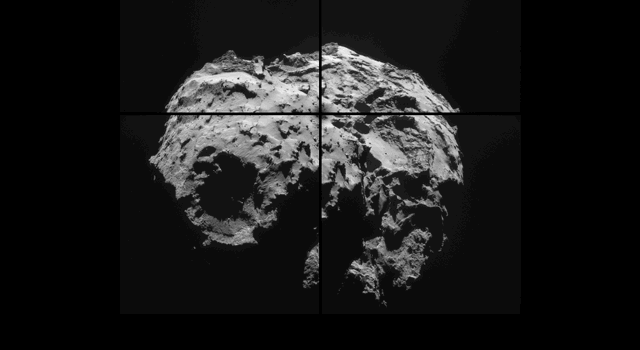
This animation comprises 24 montages based on images acquired by the navigation camera on the European Space Agency's Rosetta spacecraft orbiting Comet 67P/Churyumov-Gerasimenko between Nov. 19 and Dec. 3, 2014. Image credit: ESA/Rosetta/NAVCAM
.
There has been a significant increase in the amount of water "pouring" out of comet 67P/Churyumov-Gerasimenko, the comet on which the Rosetta mission's Philae lander touched down in November 2014.
The 2.5-mile-wide (4-kilometer) comet was releasing the earthly equivalent of 40 ounces (1.2 liters) of water into space every second at the end of August 2014. The observations were made by NASA's Microwave Instrument for Rosetta Orbiter (MIRO), aboard the European Space Agency's Rosetta spacecraft. Science results from the MIRO team were released today as part of a special Rosetta-related issue of the journal Science.
"In observations over a period of three months [June through August, 2014], the amount of water in vapor form that the comet was dumping into space grew about tenfold," said Sam Gulkis, principal investigator of the MIRO instrument at NASA's Jet Propulsion Laboratory in Pasadena, California, and lead author of a paper appearing in the special issue. "To be up close and personal with a comet for an extended period of time has provided us with an unprecedented opportunity to see how comets transform from cold, icy bodies to active objects spewing out gas and dust as they get closer to the sun."
The MIRO instrument is a small and lightweight spectrometer that can map the abundance, temperature and velocity of cometary water vapor and other molecules that the nucleus releases. It can also measure the temperature up to about one inch (two centimeters) below the surface of the comet's nucleus. One reason the subsurface temperature is important is that the observed gases likely come from sublimating ices beneath the surface. By combining information on both the gas and the subsurface, MIRO will be able to study this process in detail.
Also in the paper released today, the MIRO team reports that 67P spews out more gas from certain locations and at certain times during its "day." The nucleus of 67P consists of two lobes of different sizes (often referred to as the "body" and "head" because of its duck-like shape), connected by a neck region. A substantial portion of the measured outgassing from June through September 2014 occurred from the neck region during the afternoon.
"That situation may be changing now that the comet is getting warmer," said Gulkis. "MIRO observations would need to be carefully analyzed to determine which factors in addition to the sun's warmth are responsible for the cometary outgassing."
Observations are continuing to search for variability in the production rate and changes in the parts of the nucleus that release gas as the comet's distance from the sun changes. This information will help scientists understand how comets evolve as they orbit and move toward and then away from the sun. The gas production rate is also important to the Rosetta navigation team controlling the spacecraft, as this flowing gas can alter the trajectory of the spacecraft.
In another 67P paper released today, it was revealed that the comet's atmosphere, or coma, is much less homogenous than expected and that comet outgassing varies significantly over time.
"If we would have just seen a steady increase of gases as we closed in on the comet, there would be no question about the heterogeneity of the nucleus," said Myrtha Hässig, a NASA-sponsored scientist from the Southwest Research Institute in San Antonio. "Instead we saw spikes in water readings, and a few hours later, a spike in carbon dioxide readings. This variation could be a temperature effect or a seasonal effect, or it could point to the possibility of comet migrations in the early solar system."
The measurements on the coma were made by the Rosetta Orbiter Spectrometer for Ion and Neutral Analysis Double Focusing Mass Spectrometer (ROSINA DFMS) instrument. Measuring the in situ coma composition at the position of the spacecraft, ROSINA data indicate that the water vapor signal is strongest overall. However, there are periods when the carbon monoxide and carbon dioxide abundances rival that of water.
"Taken together, the MIRO outgassing results and results about heterogeneous fountains from ROSINA suggest fascinating new details to be learned about how comets work,"said Claudia Alexander, NASA project scientist for the U.S. Rosetta team, from JPL. "These results are helping us move the field forward on how comets operate on a fundamental level."
Rosetta is currently about 107 million miles (171 million kilometers) from Earth and about 92 million miles (148 million kilometers) from the sun. Comets are time capsules containing primitive material left over from the epoch when the sun and its planets formed. By studying the gas, dust and structure of the nucleus and organic materials associated with the comet, via both remote and in situ observations, the Rosetta mission should become a key to unlocking the history and evolution of our solar system, as well as answering questions regarding the origin of Earth's water and perhaps even life. Rosetta is the first mission in history to rendezvous with a comet, escort it as it orbits the sun, and deploy a lander to its surface.
Rosetta is an ESA mission with contributions from its member states and NASA. Rosetta's Philae lander is provided by a consortium led by the German Aerospace Center, Cologne; Max Planck Institute for Solar System Research, Go?ttingen; French National Space Agency, Paris; and the Italian Space Agency, Rome. JPL, a Division of the California Institute of Technology, Pasadena, manages the U.S. contribution of the Rosetta mission for NASA's Science Mission Directorate in Washington. JPL also built the MIRO and hosts its principal investigator, Samuel Gulkis. The Southwest Research Institute (San Antonio and Boulder), developed the Rosetta orbiter's IES and Alice instruments, and hosts their principal investigators, James Burch (IES) and Alan Stern (Alice).
Quelle: NASA
---
COMET ‘POURING’ MORE WATER INTO SPACE
Based on the NASA-JPL press release reporting the results of Rosetta’s MIRO instrument, NASA’s Microwave Instrument on the Rosetta Orbiter and with additional inputs from the MIRO team.
There has been a significant increase in the amount of water "pouring" out of comet 67P/Churyumov-Gerasimenko, report MIRO scientists in a paper published in the journal Science last night. The 4 km-wide comet was releasing the equivalent of 1.2 litres of water vapour into space every second at the end of August 2014.
"In observations over a period of three months [June through August, 2014], the amount of water in vapour form that the comet was dumping into space grew about tenfold," said Sam Gulkis, principal investigator of the MIRO instrument at NASA's Jet Propulsion Laboratory, and lead author of the new paper. "To be up close and personal with a comet for an extended period of time has provided us with an unprecedented opportunity to see how comets transform from cold, icy bodies to active objects spewing out gas and dust as they get closer to the Sun."
.

OSIRIS wide-angle camera image acquired on 22 November 2014 from a distance of 30 km from Comet 67P/C-G. The image resolution is 2.8 m/pixel.
Credits: ESA/Rosetta/MPS for OSIRIS Team MPS/UPD/LAM/IAA/SSO/INTA/UPM/DASP/IDA
.
The MIRO instrument is a small and lightweight spectrometer that can map the abundance, temperature and velocity of cometary water vapour and other molecules that the nucleus releases. It can also measure the temperature to several centimetres below the surface of the comet's nucleus.
For September, the comet subsurface temperatures were found to be in the 30 to 190 K range (approx. -243 to -83ºC), roughly 1 cm below the surface. The upper value is expected to increase significantly as the comet approaches perihelion in August this year.
While there are day/night variations at any one location, seasonal effects are the largest component of that range, with some latitudes being much colder than others. For example, the coldest values are found in the south polar region, which has been in winter – and not seen the Sun – for several years. Meanwhile the highest temperatures occur near the sub-solar latitude (which in September was in the comet’s northern hemisphere).
The extent of the day/night variations are also latitude dependent. Variations are near zero at the winter pole (meaning there is no sunlight day or night, so things don't change much over a rotation), while subsurface variations can be ~50 K at summer mid-latitudes.
.
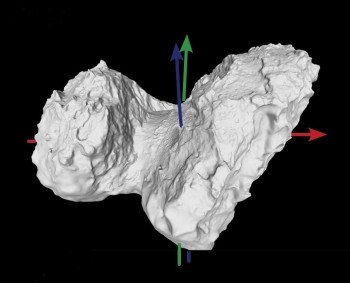
The blue arrow indicates Comet 67P/Churyumov–Gerasimenko’s rotation axis, and the red and green arrows display its equatorial x- and y-axes, respectively.
Credits: ESA/Rosetta/MPS for OSIRIS Team MPS/UPD/LAM/IAA/SSO/INTA/UPM/DASP/IDA
-
One reason the subsurface temperature determination is so important is that the observed gases likely come from sublimating ices beneath the surface. By combining information on both the gas and the subsurface, MIRO will be able to study this process in detail.
Indeed, the MIRO team already reports that 67P/C-G spews out more gas from certain locations and at certain times during its “day,” with a substantial portion of the measured outgassing from June through September 2014 occurring from the neck region during the afternoon.
"That situation may be changing now that the comet is getting warmer," said Gulkis. "MIRO observations would need to be carefully analysed to determine which factors in addition to the Sun's warmth are responsible for the cometary outgassing."
The team is continuing to search for variability in the production rate and changes in the parts of the nucleus that release gas as the comet's distance from the Sun changes. This information will help scientists understand how comets evolve as they orbit and move toward and then away from the Sun. The gas production rate is also important to the Rosetta navigation team controlling the spacecraft, as this flowing gas can alter the trajectory of the spacecraft.
“Subsurface properties and early activity of comet 67P/Churyumov-Gerasimenko” by S. Gulkis et al. is available to read in the 23 January issue of Science.
---
EXTREMELY DARK, DRY AND RICH IN ORGANICS: VIRTIS VIEW OF 67P/C-G
Based on the press release of the National Institute for Astrophysics in Italy covering the results of the VIRTIS instrument – the Visible and Infrared Thermal Imaging Spectrometer on Rosetta – that were published last night in the journal Science. The results are based on data collected by VIRTIS between August and December 2014.
The first surprising result emerging from VIRTIS’s study of Comet 67P/Churyumov-Gerasimenko is the measurement of its albedo, or how much sunlight is reflected by the surface of the nucleus. With an albedo of only 6%, about half as much as the Moon's, 67P/C-G is one of the darkest objects in the Solar System.
Such a low reflecting power indicates that the surface of the comet contains minerals such as, for example, iron sulfides, but also carbon-based compounds. The low albedo also indicates that there is little or no water ice on the outermost layers of the surface of the nucleus.
“This clearly doesn't mean that the comet is not rich in water, but only that there is no water ice in the outermost shell, just over one millimetre thick,” explains Fabrizio Capaccioni, VIRTIS Principal Investigator from INAF-IAPS in Rome, Italy. “The reason for this is rooted in the recent history of the comet's evolution, since repeated passes in the vicinity of the Sun cause surface ice to sublimate.”
.
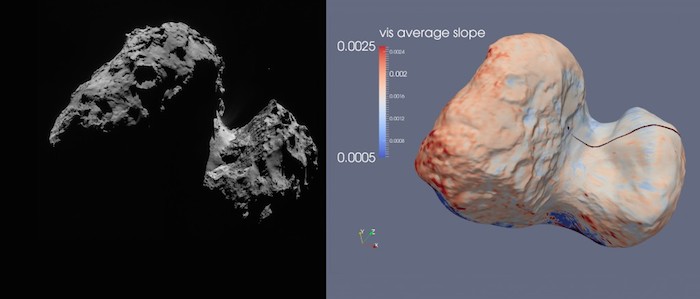
On the left, an image of the nucleus of Comet 67P/C-G obtained with the Navigation Camera (NAVCAM) on Rosetta. On the right, in a similar orientation, a map of the spectral slope of the surface of the nucleus. The spectral slope is used to extract information about the composition of the material present on the surface. Small values of the spectral slope (in blue) are clearly seen in the 'neck' region, which is the one that, to the day, has shown the largest degree of cometary activity in terms of gas and dust emission. Credit: ESA/Rosetta/NAVCAM(left); ESA/Rosetta/VIRTIS/INAF-IAPS/OBS DE PARIS-LESIA/DLR (right)
.
Another interesting result based on these infrared observations concerns the discovery of macromolecular organic compounds over the entire surface of the comet's nucleus. Some of these compounds are similar to the carboxylic acids – or actually to polymers of carboxylic acids – that are present in amino acids.
While amino acids were already observed in cometary materials and in primordial meteorites, this is the first time that such compounds are directly observed on the surface of a comet nucleus. In addition, the global distribution of such compounds on the surface suggests that they were abundant in the material that assembled to build up the nucleus of the comet.
“The formation of such compounds requires the presence of ices of volatile molecules such as methanol, methane or carbon monoxide, which only freeze at very low temperatures,” explains Capaccioni. “Therefore, these compounds must have formed at large distances from the Sun, during the early stages of the build up of the Solar System. This suggests that we are facing a comet that locks up, in its interior, traces of primordial chemical compounds that date back to the formation of our Solar System, or possibly to an even earlier epoch.”
“The organic-rich surface of comet 67P/Churyumov-Gerasimenko as seen by VIRTIS/Rosetta” by F. Capaccioni et al. is published in the 23 January issue of the journal Science.
Quelle: ESA
-
Update: 26.01.2015
.
HELLO HATMEHIT – COMETWATCH 18 JANUARY
Today’s CometWatch mosaic comprises images taken by Rosetta’s navigation camera (NAVCAM) on 18 January, from a distance of 28.4 km from the centre of Comet 67P/Churyumov-Gerasimenko. The image resolution is 2.4 m/pixel and the individual 1024 x 1024 frames measure 2.5 km across. The mosaic is slightly cropped and measures 3.7 x 4.0 km.
.
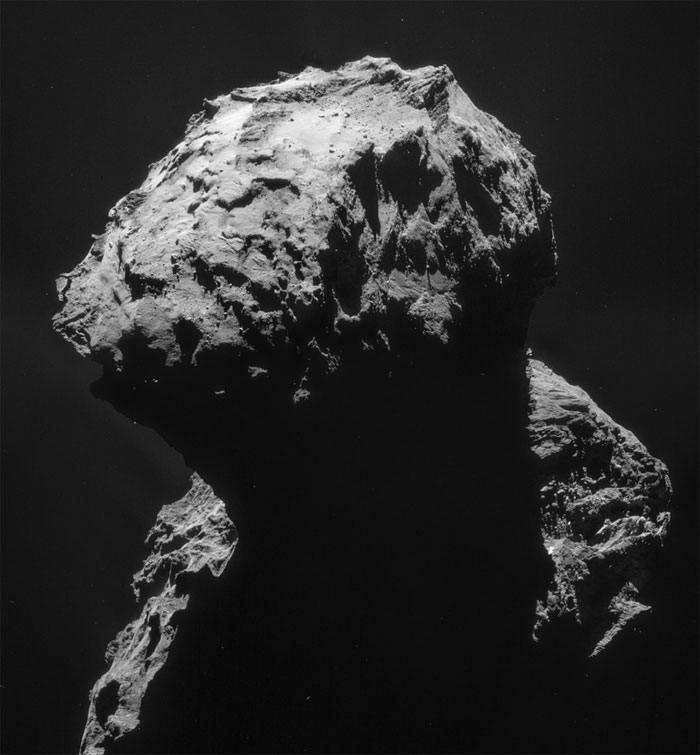
Four image mosaic comprising images taken on 18 January 2015 by Rosetta's Navigation Camera (NAVCAM). Rotation and translation of the comet during the imaging sequence make it difficult to create an accurate mosaic, and there may be some spurious spatial and intensity features as a result of the mosaic-making sequence, so always refer to the individual frames before performing any detailed comparison or drawing conclusions about any strange structures or low intensity extended emission. Credits: ESA/Rosetta/NAVCAM – CC BY-SA IGO 3.0
The mosaic focuses on the smaller of the comet’s two lobes, with the shallow, 1 km wide depression we now know to be called Hatmehit situated towards the top. Bordering Hatmehit are the Ma’at, Maftet and Bastet regions (refer to the maps here and here to get oriented with Comet 67P/C-G’s geography).
The flanks of the comet’s larger lobe can be seen in the background of this mosaic, while much of the foreground is dominated by shadow.
The four individual 1024 x 1024 frames, along with a montage of the frames, are provided below:
.
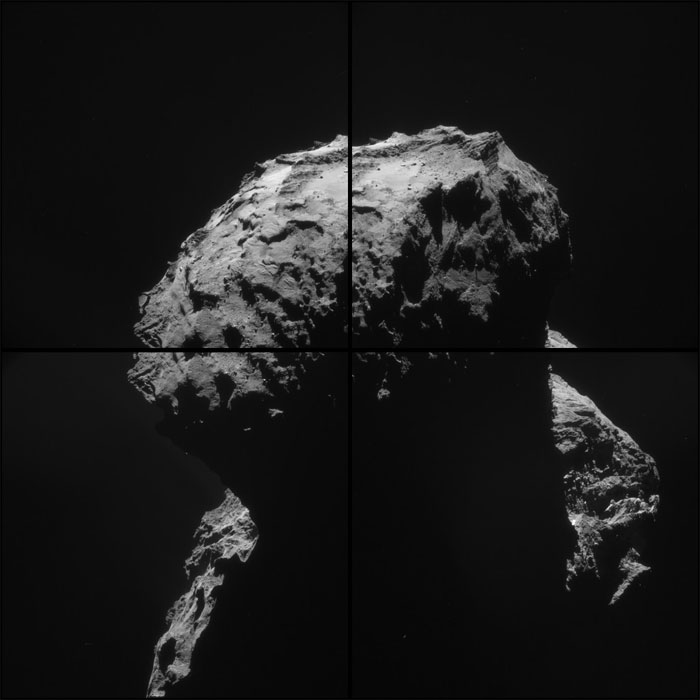
-
COSIMA WATCHES COMET SHED ITS DUSTY COAT
Early results from Rosetta's COmetary Secondary Ion Mass Analyser (COSIMA) are published today in the journal Nature. The study covers August to October, when the comet moved along its orbit between about 535 million kilometres to 450 million kilometres from the Sun, and when Rosetta was orbiting the comet at distances of 30 km or less.
This news item is also published on the ESA Portal.
COSIMA is one of Rosetta’s three dust analysis experiments. It started collecting, imaging and measuring the composition of dust particles shortly after the spacecraft arrived at the comet in August 2014.
The scientists looked at the way that many large dust grains broke apart when they were collected on the instrument’s target plate, typically at low speeds of 1–10 m/s. The grains, which were originally at least 0.05 mm across, fragmented or shattered upon collection.
The fact that they broke apart so easily means that the individual parts were not well bound together. Moreover, if they had contained ice, they would not have shattered. Instead, the icy component would have evaporated off the grain shortly after touching the collecting plate, leaving voids in what remained. By comparison, if a pure water-ice grain had struck the detector, then only a dark patch would have been seen.
.

Introducing the crumbled dust grain Eloi (a) and the shattered dust grain Arvid (b), two examples of the grains helping scientists to decipher the characteristics of 67P/C-G's dust. For both grains, the image is shown twice under two different grazing illumination conditions: the top image is illuminated from the right, the bottom image from the left. The brightness is adjusted to emphasise the shadows, in order to determine the height of the dust grain. Eloi therefore reaches about 0.1 mm above the target plate; Arvid about 0.06 mm. The two small grains at the far right of image (b) are not part of the shattered cluster. Credits: ESA/Rosetta/MPS for COSIMA Team MPS/CSNSM/UNIBW/TUORLA/IWF/IAS/ESA/
BUW/MPE/LPC2E/LCM/FMI/UTU/LISA/UOFC/vH&S
The dust particles were found to be rich in sodium, sharing the characteristics of ‘interplanetary dust particles’. These are found in meteor streams originating from comets, including the annual Perseids from Comet 109P/Swift–Tuttle and the Leonids from 55P/Tempel–Tuttle.
“We found that the dust particles released first when the comet started to become active again are ‘fluffy’. They don’t contain ice, but they do contain a lot of sodium. We have found the parent material of interplanetary dust particles,” says lead author Rita Schulz of ESA’s Scientific Support Office.
The scientists believe that the grains detected were stranded on the comet’s surface after its last perihelion passage, when the flow of gas away from the surface had subsided and was no longer sufficient to lift dust grains from the surface.
While the dust was confined to the surface, the gas continued evaporating at a very low level, coming from ever deeper below the surface during the years that the comet travelled furthest from the Sun. Effectively, the comet nucleus was ‘drying out’ on the surface and just below it.
“We believe that these ‘fluffy’ grains collected by Rosetta originated from the dusty layer built up on the comet’s surface since its last close approach to the Sun,” explains Martin Hilchenbach, COSIMA principal investigator at the Max-Planck Institute for Solar System research in Germany.
“This layer is being removed as the activity of the comet is increasing again. We see this layer being removed, and we expect it to evolve into a more ice-rich phase in the coming months.”
The comet is on a 6.5-year circuit around the Sun, and is moving towards its closest approach in August of this year. At that point, Rosetta and the comet will be 186 million kilometres from the Sun, between the orbits of Earth and Mars.
As the comet warms, the outflow of gases is increasing and the grains making up the dry surface layers are being lifted into the inner atmosphere, or coma. Eventually, the incoming solar energy will be high enough to remove all of this old dust, leaving fresher material exposed at the surface.
“In fact, much of the comet’s dust mantle should actually be lost by now, and we will soon be looking at grains with very different properties,” says Rita.
“Rosetta’s dust observations close to the comet nucleus are crucial in helping us to link together what is happening at the very small scale with what we see at much larger scales, as dust is lost into the comet’s coma and tail,” says Matt Taylor, ESA’s Rosetta project scientist.
“For these observations, it really is a case of “watch this space” as we continue to watch in real time how the comet evolves as it approaches the Sun along its orbit over the coming months.”
“Comet 67P/Churyumov–Gerasimenko to shed dust coat accumulated over the past four years,” by R. Schulz et al is published in the 26 January issue of the journal Nature.
COSIMA was built by a consortium led by the Max-Planck-Institut für Extraterrestrische Physik (Garching, DE) in collaboration with Laboratoire de Physique et Chimie de l’Environnement et de l’Espace, CNRS / Université d’Orléans (FR), Institut d’Astrophysique Spatiale, CNRS / Université Paris Sud (Orsay, FR), Finnish Meteorological Institute (Helsinki, FI), Universität Wuppertal (Wuppertal, DE), von Hoerner und Sulger GmbH (Schwetzingen, DE), Universität der Bundeswehr (Neubiberg, DE), Institut für Physik, Forschungszentrum Seibersdorf (Seibersdorf, AT), Institut für Weltraumforschung, Österreichische Akademie der Wissenschaften (Graz, AT) and is lead by the Max-Planck-Institut für Sonnensystemforschung (Göttingen, DE).
Quelle: ESA
.
Update: 28.01.2015
.
Science pours in from Rosetta comet mission
The first thorough analyses of data from the European craft suggest that comet 67P originated in the distant reaches of the Solar System.
The first major haul of research from the European Space Agency’s Rosetta mission, published in seven papers1–7 in Science on 22 January, reveals a rich and diverse landscape on 67P/Churyumov–Gerasimenko, the most studied comet in history. The best images — some of which had been presented first in December at a meeting of the American Geophysical Union — are pictured below.
Charting gravity

Using data from the Optical, Spectroscopic, and Infrared Remote Imaging System (OSIRIS) and the Radio Science Investigation instrument, the Rosetta mission team calculated the comet’s gravitational field1. The gravitational potential (pictured) also takes into account a pull caused by the comet’s rotation. The resulting force is greatest on top of the lobes, but it is about six times weaker in the neck region, where dust can lift off more easily. The team also used the data to calculate the comet’s density, finding that the body is relatively fluffy and porous — with a density of around half that of water, giving clues as to its structure and strength.
Different terrains

Images taken by the OSIRIS camera reveal vastly different kinds of terrain, including dunes, ripples and fractures2. Rosetta scientists have split the comet into regions defined by surface structure (see false-colour image), with each named after an Egyptian god. Hatmehit, for example, is a smooth depression on the 'head' of the duck-shaped comet that could be a dust-filled impact crater. Other areas, such as Seth and Hathor, are rough with steep cliff-like structures. However, the porosity of the comet means that rock-like structures are in fact compacted dust. Many structures look as though they are formed by gas moving dust around the surface, say the authors, in the same way that wind shapes sand in a desert.
Clues to the origins
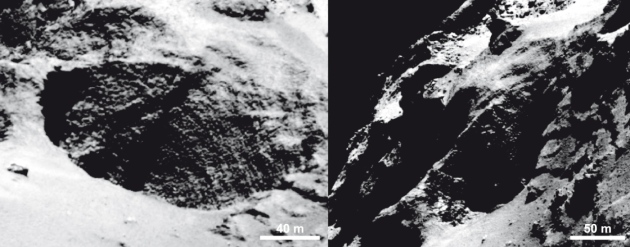
Detailed pictures, at their best with a resolution of 15 centimetres per pixel, show structures that could hint at the comet’s history1. Three-metre-wide features nicknamed “goosebumps”, pictured here running down the inside of a pit in the Seth region, are found all over the comet. Holger Sierks of the Max Planck Institute for Solar System Research in Göttingen, Germany, who is principal investigator on the OSIRIS camera instrument, says that the pebble-like shapes could hint at the scale on which grains of dust and ice first clumped together in the early Solar System. “The hypothesis is these might be the building blocks of comets,” he says
The neck riddle

Data from several instruments show that the comet’s neck is the source of most of its streaming gas and dust. To understand why the region is so active, the Rosetta team looked at how much thermal energy hits the surface per 12.4-hour rotation (left) and per 6.5-year solar orbit (right). The neck receives less energy from the Sun than the rest of the comet because it is shaded, but they found that a suntrap effect from radiation bouncing between opposite cliff walls goes some way towards compensating for that. Other possible reasons for the region's high activity include its low gravitational pull, which means that little force is needed to blow dust away, and that the region might have a different composition than other regions, or have more ready access to water beneath the surface1. The team has still to answer whether the neck denotes a join between two comets or has been carved out of a single comet by erosion. Evidence of differences between the two lobes would indicate the former, but so far the two lobes seem to have very similar structures, says Sierks.
Coming from afar
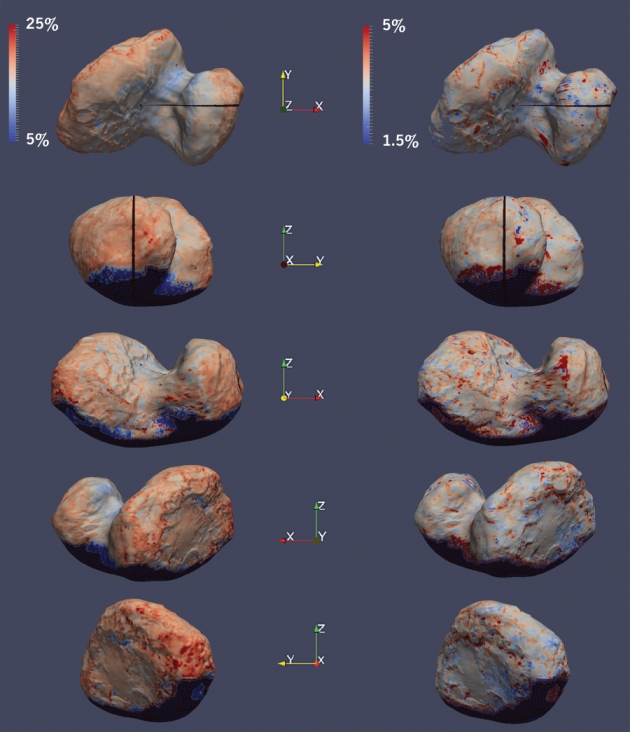
This visible and infrared portrait of 67P’s surface, obtained by the Visible and Infrared Thermal Imaging Spectrometer (VIRTIS), shows an abundance of opaque, organic compounds, but very little water ice. This would be consistent with an origin for the comet in the distant Kuiper belt — beyond the orbit of Neptune — rather than closer to Jupiter, as its current orbit would suggest4.
Quelle: nature
.
Update: 19.00 MEZ
.
COMETWATCH – 21 JANUARY
Today’s CometWatch mosaic comprises images taken by Rosetta’s navigation camera (NAVCAM) on 21 January, from a distance of 27.9 km from the centre of Comet 67P/Churyumov-Gerasimenko. The image resolution is 2.4 m/pixel and the individual 1024 x 1024 frames measure 2.4 km across. The mosaic is slightly cropped and measures 4.2 x 4 km.
.
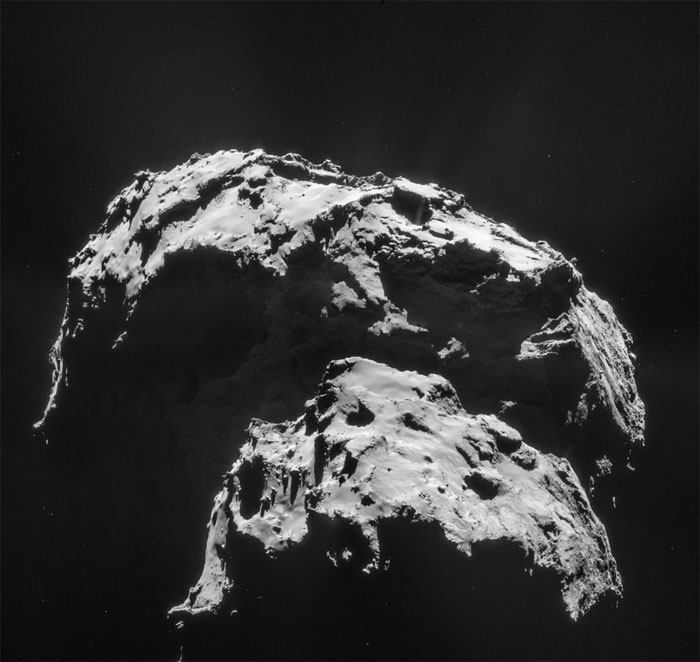
Four image mosaic comprising images taken on 21 January 2015 by Rosetta's Navigation Camera (NAVCAM). Rotation and translation of the comet during the imaging sequence make it difficult to create an accurate mosaic, and there may be some spurious spatial and intensity features as a result of the mosaic-making sequence, so always refer to the individual frames before performing any detailed comparison or drawing conclusions about any strange structures or low intensity extended emission. Indeed, for this image set, the feature near the centre of the mosaic is a compromise of the top two frames. Credits: ESA/Rosetta/NAVCAM – CC BY-SA IGO 3.0
In this orientation we see the small comet lobe in the foreground and the large lobe in the background, with the overall view giving the appearance that the duck-shaped comet is lying down on its side. The small lobe presents the Baset (right) and Ma’at (left) regions, while the body includes Khepry (the seemingly flat edge at the far right), and the dust-dominated Babi and Ash regions. (Click here for a useful region map.)
Looking particularly dramatic in this view is the raised plateau close to the far horizon, just right of centre. Zooming in to its edge reveals crevice-like features that appear similar to those identified in the Seth region as precursors to collapse. Don't miss the bright emission that is contrasted against the shadowed wall of this feature, too!
You might also like to ramp up the contrast to bring the Seth region out of the shadows.
The four 1024 x 1024 pixel images making up the mosaic, along with a montage, are provided below:
.
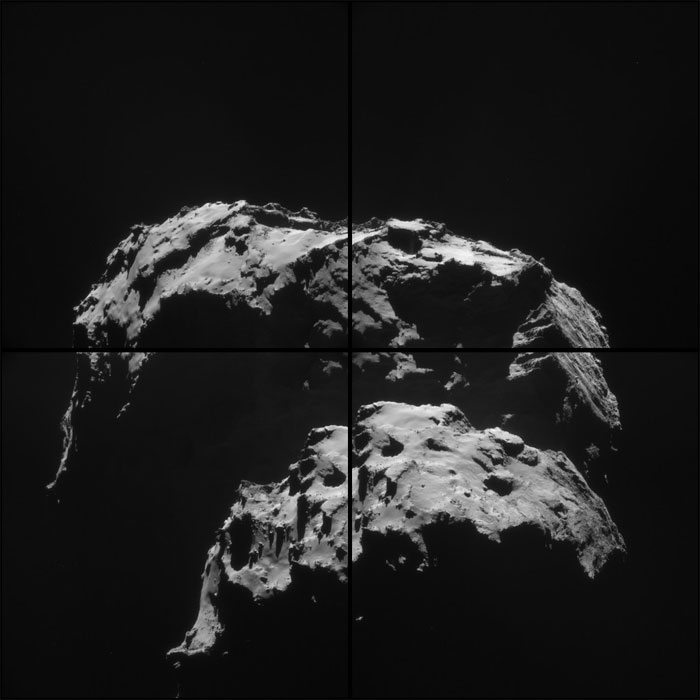
.
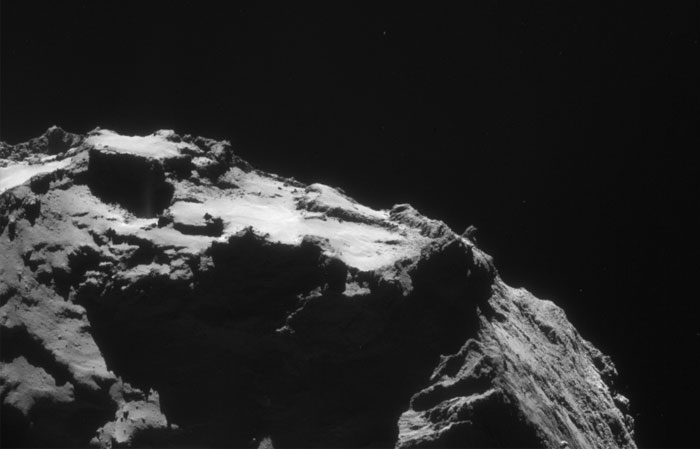
.

Quelle: ESA
5290 Views
